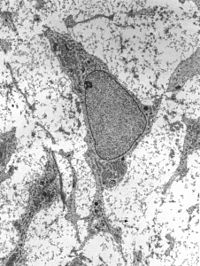
Photo from wikipedia
(1) Treatment failure of oral squamous cell carcinoma (OSCC) is generally due to the development of therapeutic resistance caused by the existence of cancer stem cells (CSCs), a small cell… Click to show full abstract
(1) Treatment failure of oral squamous cell carcinoma (OSCC) is generally due to the development of therapeutic resistance caused by the existence of cancer stem cells (CSCs), a small cell subpopulation with marked self-renewal and differentiation capacity. Micro RNAs, notably miRNA-21, appear to play an important role in OSCC carcinogenesis. Our objectives were to explore the multipotency of oral CSCs by estimating their differentiation capacity and assessing the effects of differentiation on stemness, apoptosis, and several miRNAs’ expression. (2) A commercially available OSCC cell line (SCC25) and five primary OSCC cultures generated from tumor tissues obtained from five OSCC patients were used in the experiments. Cells harboring CD44, a CSC marker, were magnetically separated from the heterogeneous tumor cell populations. The CD44+ cells were then subjected to osteogenic and adipogenic induction, and the specific staining was used for differentiation confirmation. The kinetics of the differentiation process was evaluated by qPCR analysis of osteogenic (Bone Morphogenetic Protein—BMP4, Runt-related Transcription Factor 2—RUNX2, Alkaline Phosphatase—ALP) and adipogenic (Fibroblast Activation Protein Alpha—FAP, LIPIN, Peroxisome Proliferator-activated Receptor Gamma—PPARG) markers on days 0, 7, 14, and 21. Embryonic markers (Octamer-binding Transcription Factor 4—OCT4, Sex Determining Region Y Box 2—SOX2, and NANOG) and micro RNAs (miRNA-21, miRNA-133, and miRNA-491) were also correspondingly evaluated by qPCR. An Annexin V assay was used to assess the potential cytotoxic effects of the differentiation process. (3) Following differentiation, the levels of markers for the osteo/adipo lineages showed a gradual increase from day 0 to day 21 in the CD44+ cultures, while stemness markers and cell viability decreased. The oncogenic miRNA-21 also followed the same pattern of gradual decrease along the differentiation process, while tumor suppressor miRNA-133 and miRNA-491 levels increased. (4) Following induction, the CSCs acquired the characteristics of the differentiated cells. This was accompanied by loss of stemness properties, a decrease of the oncogenic and concomitant, and an increase of tumor suppressor micro RNAs.
Journal Title: International Journal of Molecular Sciences
Year Published: 2023
Link to full text (if available)
Share on Social Media: Sign Up to like & get
recommendations!